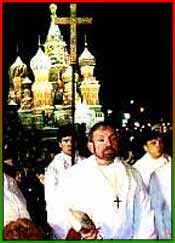 The icon of St. Nicholas is especially popular in Russia. The legend is that the 11th-century Prince Vladimir traveled to Constantinople to be baptized, and returned with stories of miracles performed by St. Nicholas of Myra. The feast of St. Nicholas (December 6) was observed for many centuries, but after the communist revolution, the celebration of the feast was suppressed, only to return after the fall of Communism.
The icon of St. Nicholas is especially popular in Russia. The legend is that the 11th-century Prince Vladimir traveled to Constantinople to be baptized, and returned with stories of miracles performed by St. Nicholas of Myra. The feast of St. Nicholas (December 6) was observed for many centuries, but after the communist revolution, the celebration of the feast was suppressed, only to return after the fall of Communism.
Most Christian Russians belong to the Eastern Orthodox Church, and it is customary to fast until after the first church service on January 6, Christmas Eve. The church in Russia still uses the old Julian calendar, therefore their Christmas celebration is 13 days behind the Gregorian calendar that we use.
Christmas Eve dinner is meatless but festive. The most important ingredient is a special porridge called kutya. It is made of wheatberries or other grains which symbolize hope and immortality, and honey and poppy seeds which ensure happiness, success, and untroubled rest. A ceremony involving the blessing of the home is frequently observed. The kutya is eaten from a common dish to symbolize unity. Some families used to throw a spoonful of kutya up to the ceiling. According to tradition, if the kutya stuck, there would be a plentiful honey harvest.
For many Russians, a return to religion represents a return to their old roots and their old culture. Throughout Russia, after Christmas Eve services, people carrying candles, torches, and homemade lanterns parade around the church, just as their grandparents and great-grandparents did long ago. After the procession completes its circle around the church, the congregation reenters and they sing several carols and hymns before going home for a late Christmas Eve dinner.